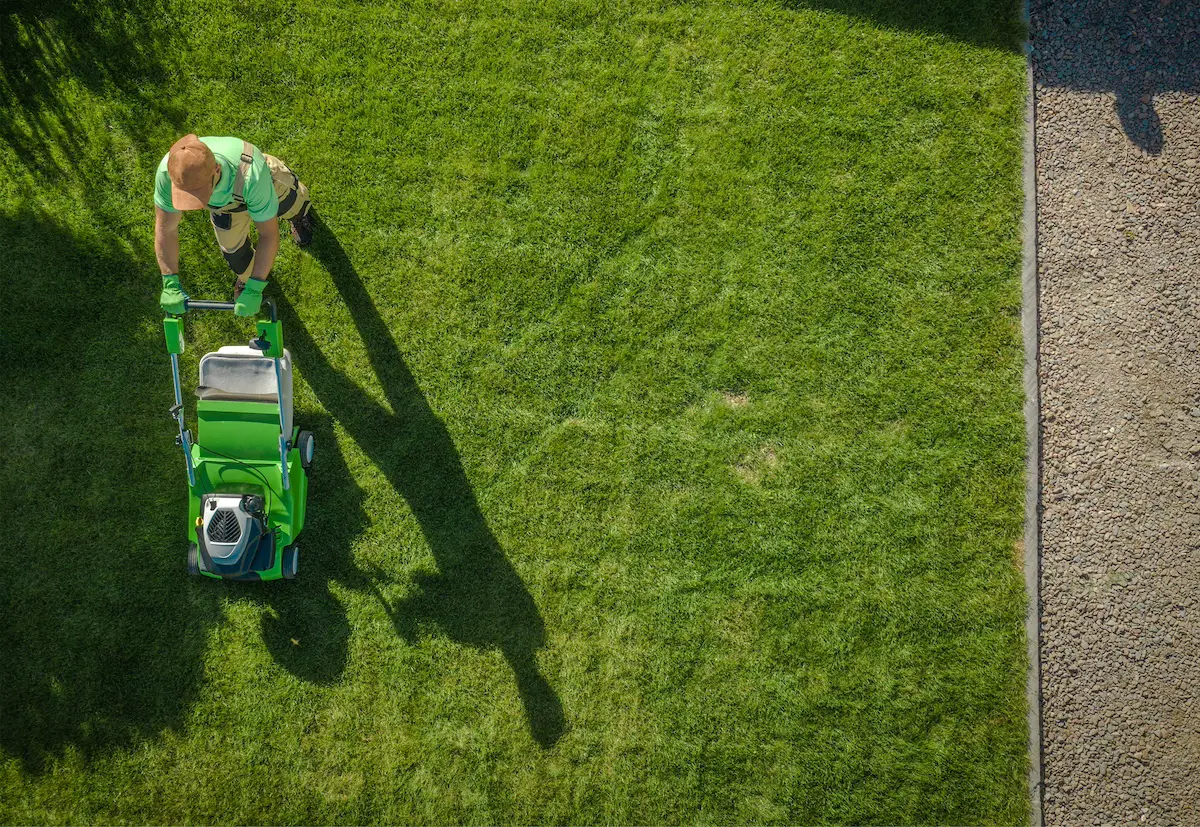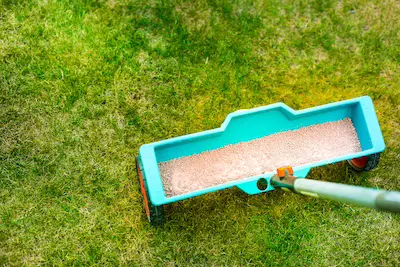Lawn care is like solving a puzzle; it involves knowing the right pieces to put in place. From mowing your grass with precision to feeding it just the right nutrients, and managing those unwelcome weeds, this article covers various techniques that lead to a healthier, more vibrant lawn.
With the proper approach and a bit of effort, the grass can indeed be greener on your side of the fence.
Lawn Care: Mowing Techniques
Ensuring your lawn stays green and healthy isn’t just about regular watering and sunlight; it’s also about how and when you mow. A well-mowed lawn not only looks tidy but also supports healthier grass growth. Here’s your go-to guide for mowing your lawn right.
Understanding Lawn Care Mowing Height and Frequency
First things first, the length at which you cut your grass matters significantly. Cutting your grass too short can stress it, making it more susceptible to pests and disease. On the other hand, leaving it too long can encourage pests and mold. The sweet spot? Aim to cut only the top 1/3 of the grass blades at any time. This height helps protect the roots from the sun and encourages stronger, deeper root growth.
As for frequency, it varies depending on the season. During the rapid growth season (spring and early summer), you might find yourself mowing once a week. In the slower growth season, every two to three weeks might be sufficient. The golden rule is to never remove more than 1/3 of the blade length at a mow to avoid stressing the grass.
Selecting the Right Mower
Not all lawnmowers are created equal. For a healthy lawn, use a mower that suits your garden size and grass type. A sharp, well-maintained blade is crucial. Dull blades tear the grass, causing damage and potential disease. After each mow, give your mower a quick clean to keep it in top condition.
Mowing Pattern Matters
It might be tempting to mow in the quickest pattern possible, but varying your mowing direction each time encourages more upright growth and reduces wear patterns. Try not to mow when the grass is wet; this can lead to uneven cuts and spread lawn disease.
Leave the Clippings
Believe it or not, leaving the clippings on the lawn can be beneficial. They act as a natural fertilizer, returning essential nutrients to the soil. If you’re mowing regularly and only cutting the top third of the grass, the clippings will be short enough to decompose quickly and won’t smother the grass.
Watering and Mowing
Water plays a key role in how often and when you should mow. It’s best to mow when the grass is dry to prevent disease spread and ensure an even cut. Water your lawn deeply but infrequently to encourage deep root growth, which makes for a stronger, more drought-resistant lawn.
Following these lawn care guidelines, you can master lawn mowing to promote lush, healthy growth. Remember, consistent lawn care and correct mowing practices are the keys to a beautiful lawn that can withstand the challenges of pests, disease, and weather.

Lawn Care: Lawn Fertilizing Schedule
Feeding your lawn is crucial for a lush, green yard. But knowing when and how to fertilize is key to getting it right. Let’s dive into the basics of lawn fertilization, ensuring your grass gets exactly what it needs without the fuss.
When to Fertilize Your Lawn
The timing largely depends on the type of grass you have. Cool-season grasses thrive with fertilization in early spring and fall, when they’re actively growing.
This includes types like Kentucky bluegrass and fescue. For warm-season grasses, such as Bermuda and zoysia, the ideal times are late spring and summer. Remember, the goal is to feed your lawn when it’s growing most vigorously.
A good rule of thumb is to fertilize your lawn every 6-8 weeks during the active growth period. However, be cautious not to over-fertilize, as this can lead to excess growth, lawn disease, and environmental harm.
Choosing the Right Fertilizer
Selecting the appropriate fertilizer makes a big difference. Look for a blend suited to your specific type of grass. Fertilizers are labeled with three numbers, representing the percentage of nitrogen, phosphorus, and potassium, respectively. Nitrogen is key for leaf growth, making it a critical component for a healthy lawn.
Organic options, like compost or manure, can be excellent choices for a more natural approach. These not only feed the lawn but also improve soil health over time.
How to Fertilize Correctly
Fertilizing isn’t just about throwing some nutrients on the lawn and calling it a day. It requires technique to do it properly:
- Use a spreader. A broadcast or drop spreader ensures even coverage, reducing the risk of “fertilizer burn”.
- Read instructions. Always follow the fertilizer package directions for the best results.
- Water lightly. After fertilizing, give your lawn a light watering to help the nutrients soak into the soil, but avoid washing them away.
Protecting Waterways
Be mindful of not fertilizing before a heavy rain. Excess fertilizer can run off into local waterways, causing pollution. Also, keep fertilizer at least a few feet away from any water bodies in your yard to prevent direct contamination.
Incorporating these fertilizing tips into your lawn care routine can significantly impact your lawn’s health and appearance. With the right timing, product, and application technique, you’re setting your lawn up for success.
Whether you’re aiming for the lushness of a golf course or simply seeking to improve your yard’s look, taking the time to fertilize correctly pays off in the long run. Remember, a well-fed lawn is a happy lawn.
Lawn Care: Weed Prevention and Control
Weeds are the uninvited guests of your lawn that compete with your grass for nutrients, light, and space. Let’s discuss effective strategies to prevent and control these pesky plants and keep your lawn looking its best.
Mulching for Weed Management
Mulches provide a physical barrier that prevents weed seeds from reaching the soil and germinating. Organic mulches like wood chips or straw not only block weeds but also improve soil health as they decompose. Apply a 2-3 inch layer around plants and in garden beds to suppress weed growth. Remember, too much mulch can suffocate your plants, so be mindful of the thickness.
Landscape Fabric: A Weed Barrier
Installing landscape fabric underneath mulch can add an extra layer of defense against weeds. This permeable material allows water and air to reach the soil while keeping weeds at bay. It’s ideal for garden beds but avoid using it in vegetable gardens where you might want to rotate crops.
Pre-Emergent Herbicides
These herbicides are applied to the soil before weeds grow. They target weed seeds, preventing them from germinating.
Timing is crucial for pre-emergent herbicides; you’ll want to apply them in early spring before soil temperatures rise enough for weed seeds to sprout. Read labels carefully to ensure the product is safe for your lawn type and the timing is right.
Spot Treatment with Post-Emergent Herbicides
For weeds that have already sprouted, post-emergent herbicides can help. They’re designed to target weeds without harming your grass, but be sure to choose a selective herbicide that won’t harm your desired plants. Spot treat individual weeds rather than blanket spraying the entire lawn to minimize chemical usage and protect beneficial plants and insects.
Hand-Pulling and Cultivation
Sometimes, nothing beats the old-fashioned method of pulling weeds by hand, especially if they’re few and far between. Use a weed puller tool for deep-rooted species like dandelions to get the whole root out. Cultivating or hoeing your garden beds lightly can disrupt weed seedlings without bringing new seeds to the surface.
Healthy Lawn Care Practices
A thick, vigorous lawn can outcompete most weeds. Overseeding patches, choosing the right grass type for your area, and addressing problems like compacted soil or poor drainage can make your lawn an inhospitable place for weeds. Disease-resistant, regionally appropriate grass types can further enhance your lawn’s ability to stand up to weeds.
Know Your Enemy
Identify the types of weeds plaguing your garden. Different weeds have different life cycles and may require specific strategies to control. Understanding whether you’re dealing with annuals, perennials, or biennials will guide your prevention and control tactics.
Lawn Care Consistency is Key
Regularly monitor your lawn and garden beds for new weed growth. Early intervention is easier and more effective than dealing with large, established weeds. Adjust your strategies as needed, and remember that weed control is a seasonal task.
By combining these strategies, you’ll effectively manage weeds, leaving your lawn lush, healthy, and inviting. Remember, patience and persistence are your best tools in the fight against weeds. Happy gardening!

Mastering Lawn Care
Through understanding and applying the lawn care techniques discussed, from precision mowing to diligent weed control, you’re well on your way to nurturing a lawn that looks great and is healthier and more resilient.
It’s about more than just appearances. A well-kept lawn creates a space for family and friends to enjoy, boosting your home’s curb appeal and even contributing to the local ecosystem. With the right lawn care and attention, your lawn can become a source of pride and joy, reflecting the hard work you’ve put into it.


